Treet Them Well
Trees supply oxygen. REALLY GOOD trees supply avocados. Or cherries.
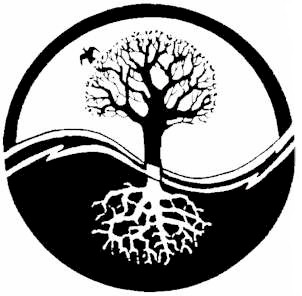
In the 6 November Evening Post, in an article entitled "Timing Wrong for Tree Move," I read where Department of Conservation botanist Philip Simpson said "No one owns
trees. They are shared and respected and loved by the whole community. Landowners often don't realise that."
I agreed wholeheartedly - but then realised that that makes the forestry trust (in which we had invested to qualify us for residency) nothing more than a factory farm. Does
this make it as morally unsound as raising chickens in cages?
We had already decided at this point that the forestry trust hadn't been such a good idea - however, by then, there was nothing we could do about it. At a basic level, I know
that life feeds on life. Our boat was once the better part of several lovely trees. So were what are now the structural skeletons of many of the buildings in Wellington.
That doesn't make me feel good about it, though. Over the 30 or so years of their lives, managed forests build up quite an ecosystem which is totally destroyed at harvest (see
Clearcutting's Soil Effects further in this section).

Do you suppose this tree is "...shared, respected, and loved by the whole community"? (I heard the apple pickers voted her
Most Likely to Suck Seed...)

I'm sorry, I don't know the source of this picture as I've lost the book of photographs from which it was taken. My apologies to the photographer, a lady (as I recall) of
talent and imagination.


Another branch of the family tree?
Source: thesun.co.uk sent to them by Jacqui Blackthorn

420 Feet Is the Limit for Towering Redwoods
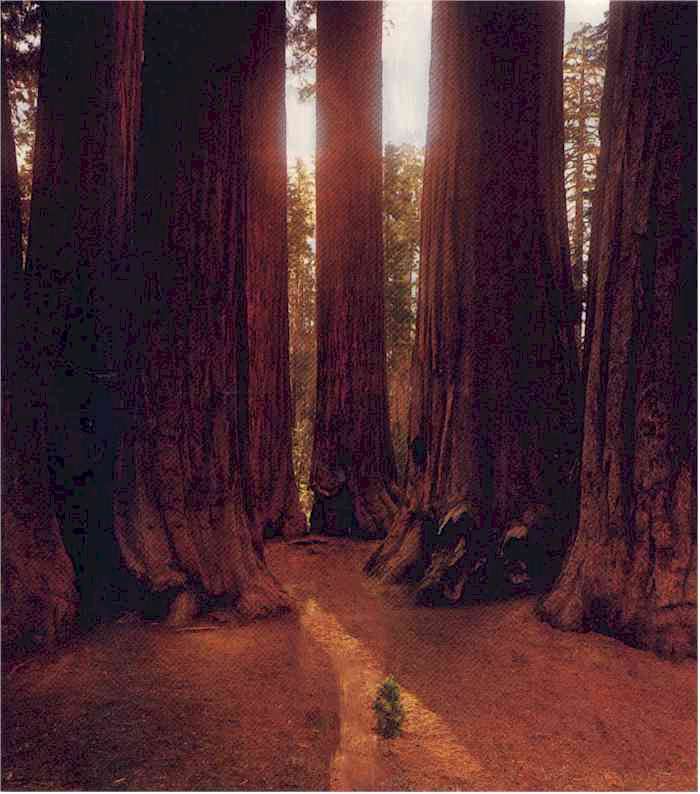
Here's a nice grove of redwoods - with a baby redwood getting ready to join the firm in a mere 600 years or so...

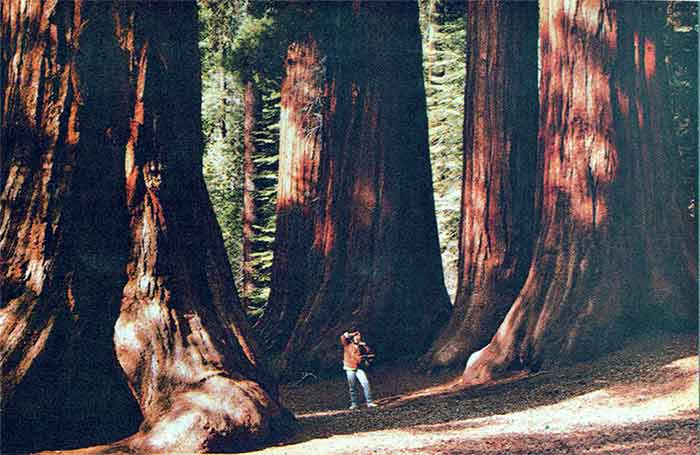
Redwood trees are the tallest living things on earth, but there's a limit to their height that probably cannot be overcome no matter how ideal the growing conditions, a study
suggests. The tallest a redwood might ever grow is about 420 feet - a height reached in the past but not in evidence today after decades of logging, says a study in
Nature. Measurements of trees in Humboldt Redwoods State Park in northern California show that 4 major factors in tree growth affect maximum height. Water flow, leaf
density, photosynthesis and CO2 concentration lose efficiency at the heights reached by the California redwoods. "We were quite surprised by that," says study leader
George Koch of Northern Arizona University. "If you only look for one factor, it wouldn't impress you very much. But when they converge in a very narrow range, that did
impress us." The 5 trees in the study included the tallest known tree - which stands about 370 feet, the equivalent of a 30-story building. The others were the second-,
fourth-, sixth- and eighth tallest known trees in the world, all in the same park.
Source: USA Today Thursday 22 April 2004

A Nice Tree for Kids
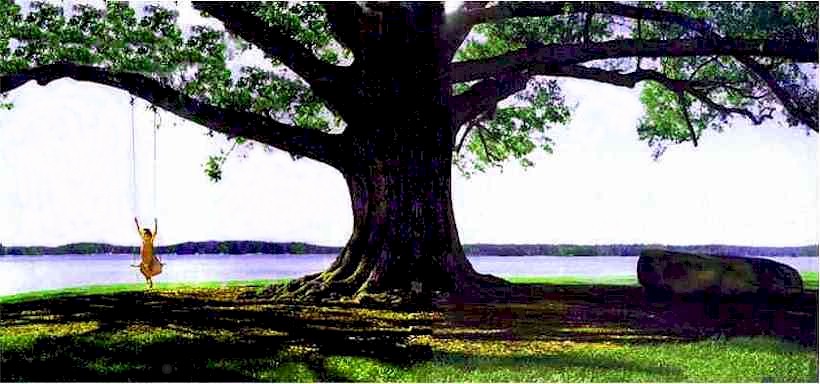
Why not plant a tree this weekend?

Do Trees Have Rights?
by Jeremy Waldron
Do trees have rights? Radical conservationists who oppose the logging of redwoods in the American Northwest, or the destruction of the tropical rainforests, sometimes claim
that they do. The forests, they say, have been here much longer than we have, and have as much right to exist as the rapacious human species that is destroying them. Arguing
that trees have rights is their way of insisting that there is something to be said on the trees' behalf in environmental disputes, quite apart from what we say on behalf of the
humans involved (who may or may not have an interest in letting the trees live).
Philosophers are more cautious about rights-talk. Rights, they say, are not to be invoked lightly, and certainly not to be attributed on every occasion when some entity is
deemed worthy of protection. If one wants to speak out on behalf of trees, and if a given tree has no instrumental value - that is, no value to anyone (its utility as shade or
scenery, for example, or its contribution to the air we breathe) - one should begin by saying, not that the tree has rights, but that it embodies some intrinsic value.
The concept of intrinsic value is less familiar than that of rights, and is a difficult one to isolate. As far as we know, human beings alone make judgments of intrinsic value,
and it is easy to confuse the proposition that we judge something to be of value with the instrumental proposition that something is judged to be of value to us.
Nevertheless, there could not be instrumental value unless there were intrinsic value: the chain of instrumentality must end somewhere. In utilitarian ethics, it comes to an
end in human well-being and happiness.
If we assert that trees have intrinsic value, however, we are saying there are ultimate ends in the world besides humans and their experiences: that it is objectively a bad thing if
a tree is killed, not because any person loses anything thereby, but because the universe is a poorer place on that account. Something that was alive and growing is so no
longer. Or if we don't think that about the individual tree, we may think it about a species of tree. Even apart from what we lose (in terms of a natural pharmacopoeia, for
example), we may think our world impoverished - made a less rich, a less colorful, a less value-laden place - every time a species becomes extinct.
Intrinsic value takes us this far, but rights convey much more. If some entity has a right to exist, then there is a strong, if not absolute prohibition on destroying it, quite
different from the qualms that even radical conservationists must have about defending trees in their gardens purely for aesthetic convenience. They are even willing to bargain
with the timber industry, about logging so many trees and no more. These attitudes would be incomprehensible on the assumption that they really believed trees have rights. In
any case, that belief is implausible on its own merits. In our culture, rights are reserved for entities which not only have intrinsic value, but which in some sense value
themselves: entities that are sentient, that have a point of view, and are in principle capable of asserting the claims that their rights embody. None of this is true of trees.
Treating trees as persons may have certain rhetorical advantages for the conservation movement, but on the whole it seems wiser to stick with the language of intrinsic value than to
flirt with sylvan rights.
Source: Anderson Valley Advertiser date unknown, but at least 5 years ago

Chinese Man Grows His Own Chairs
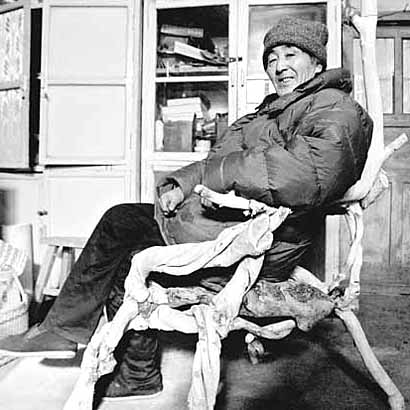 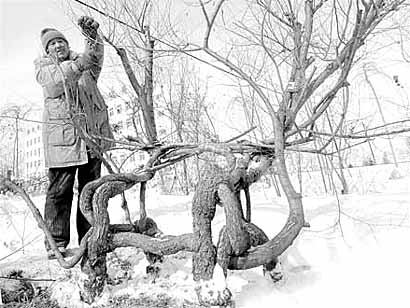
Left: Mr Wu sits in his wooden chair / Lu Feng
Mr Wu, from Shenyang City, Liaoning province, moulds branches into shape while the tree is still growing.
A Chinese man has patented his technique for growing his own wooden chairs. He uses elm trees which are pliant and do not break easily, reports the China Morning
Business View. Mr Wu, who's in his 60s, says it takes him about 5 years to grow a tree chair, from saplings to the finished article. As the "chair" grows, he
constantly trims and guides it into shape before the chair is finally harvested.
Mr Wu has one tree chair in his home, which he harvested last September, and six more growing in his field. He hopes that one day people will be able to grow all of their
furniture instead of having to buy it from a store.
Source: ananova.com Wednesday 2 February 2005

Gateway Trees

Source: darkroastedblend.com
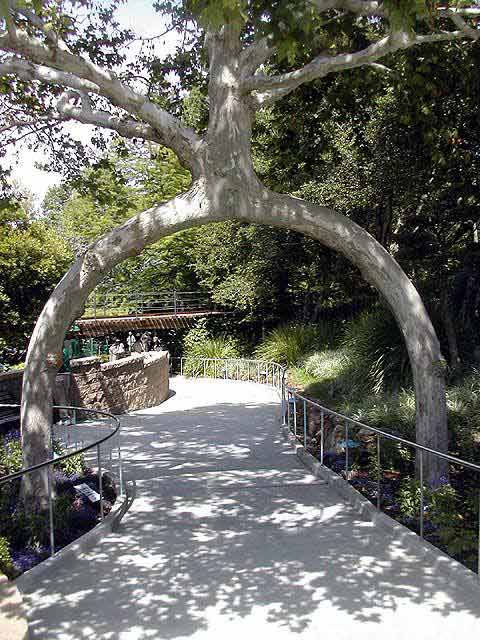
A creation of Axel Erlandson (see article "The Art of Basketree" below)

A 4,768-year-old bristlecone pine (called "Methuselah") in California is the world's oldest known living tree.

The Trees Are Down
...and he cried with a loud voice: Hurt not the earth, neither the sea, nor the trees...
- Revelation
by Charlotte Mew (1869 - 1928)
They are cutting down the great plane-trees at the end of the gardens.
For days there has been the grate of the saw, the swish of the branches as they fall,
The crash of the trunks, the rustle of trodden leaves,
With the 'Whoops' and the 'Whoas', the loud common talk,
the loud common laughs of the men, above it all.
I remember one evening of a long past Spring
Turning in at a gate, getting out of a cart, and finding a large dead rat in the mud of the drive.
I remember thinking: alive or dead, a rat was a god-forsaken thing,
But at least, in May, that even a rat should be alive.
The week's work here is as good as done. There is just one bough
On the roped bole, in the fine rain,
Green and high
And lonely against the sky.
(Down now!-)
and but for that,
If an old dead rat
Did once, for a moment, unmake the Spring, I might never have thought of him again.
It is not for a moment the Spring is unmade to-day;
These were great trees, it was in them from root to stem:
When the men with the 'Whoops' and the 'Whoas' have carted the whole
of the whispering loveliness away
Half the Spring, for me, will have gone with them.
It is going now, and my heart has been struck with the hearts of the planes;
Half my life it has beat with these, in the sun, in the rains,
In the March wind, the May breeze,
In the great gales that came over to them across the roofs from the great seas.
There was only a quiet rain when they were dying;
They must have heard the sparrows flying,
And the small creeping creatures in the earth where they were lying -
But I, all day, I heard an angel crying:
"Hurt not the trees".
Source:
bbc.co.uk/nature/poetry/the_trees_are_down.shtml

Wooden Stars?


Source: Bogor by Burton Silver, Silviculture Press 1985

I have an idea - in the final episode, treedom fighters come through and save all the trees. Pretty cool, huh?

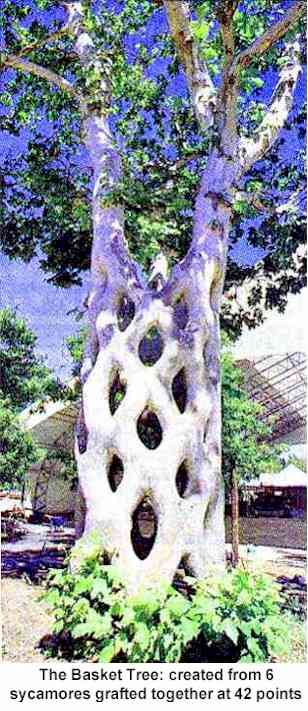 The Art of Basketree The Art of Basketree
by Marco R della Cava
Gilroy California - At first glance, the Circus trees of Bonfante Gardens appear to be freaks of nature or plastic sculptures. A closer look reveals them to be the
offshoots of one man's lifelong passion, arboreal wonders coaxed and grafted by dedicated hands into spirals, hoops and webs.
Now, 29 of these astonishing trees, saved from a firewood fate when they were purchased in 1984, call Michael Bonfante's theme park home. After 16 years of being
tended in storage, they were replanted throughout the property.
"I couldn't let these beauties die," says Bonfante, an avowed tree fanatic. "The work that went into creating them just amazes me."
In the 1920s, Axel Erlandson, a California farmer, was impressed by the natural fusing of two sycamore trees and began tinkering with nature's work. His debut work,
on display at Bonfante Gardens, is Four-Legged Giant - four sycamores that arch into the same trunk at a point roughly 8 ft high.
From there, Erlandson went on to create nearly 80 Circus Trees, using sycamores, box elders, ash and Spanish cork oak. His designs took on mind-bending shapes, from a basket
weave to a heart-shaped loop. The trees had their time in the spotlight in the 1940s and '50s, with features in Life magazine and Ripley's Believe It or Not.
Seeing the contortions these branches endure makes one wonder if the transformation - which included slowing down growth of trunks and limbs - is injurious. Not so, says
Dennis Desjardin, a biologist at San FranciscoState University. "There's no danger to the tree so long as you see leaves sprouting out so it can photosynthesize," he
says. "With skill, you could take a healthy tree and spell your name out in script."
Though Erlandson died in 1964, his signatures thrive.
Source: USA Today Friday 15 June 2001
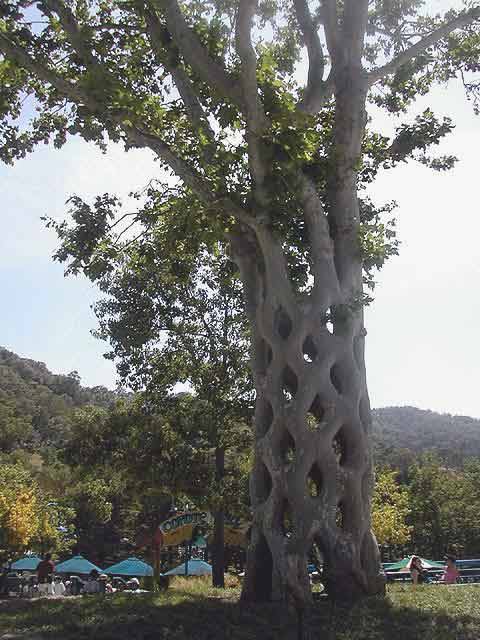 A Larger Basketree A Larger Basketree

To see more beautiful tree pictures - these are of the incredible, versatile baobab tree - click the "Next" button below to take you to the following page, "The Jewel of the Savannah".
There are also three pages of gorgeous forest photos in the section on Photographs beginning here.

For pages on natural disasters - including lightning strikes, tornados, hurricanes, volcanoes, floods, global warming and more - as well as some great satellite photos, clicking
the "Up" button immediately below takes you to the Table of Contents page for this Environment section.
|  Animals
Animals Animation
Animation Art of Playing Cards
Art of Playing Cards Drugs
Drugs Education
Education Environment
Environment Flying
Flying History
History Humour
Humour Immigration
Immigration Info/Tech
Info/Tech Intellectual/Entertaining
Intellectual/Entertaining Lifestyles
Lifestyles Men
Men Money/Politics/Law
Money/Politics/Law New Jersey
New Jersey Odds and Oddities
Odds and Oddities Older & Under
Older & Under Photography
Photography Prisons
Prisons Relationships
Relationships Science
Science Social/Cultural
Social/Cultural Terrorism
Terrorism Wellington
Wellington Working
Working Zero Return Investment
Zero Return Investment











 The Art of Basketree
The Art of Basketree A Larger Basketree
A Larger Basketree